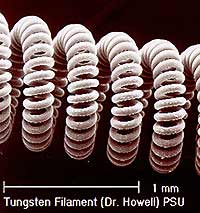Solar & Battery Fan DIY STEM Kit
$9.99$6.50
 An incandescent light bulb contains a thin wire filament (usually tungsten) that glows hot
when an electric current is run through it. In the presence of oxygen, the filament would
burn up as a result of the high temperature. A glass bulb, then, is used to keep oxygen
away from the filament.
An incandescent light bulb contains a thin wire filament (usually tungsten) that glows hot
when an electric current is run through it. In the presence of oxygen, the filament would
burn up as a result of the high temperature. A glass bulb, then, is used to keep oxygen
away from the filament.
 'Physicists like to think that all you have to do is say, these are the conditions, now what happens next?'
'Physicists like to think that all you have to do is say, these are the conditions, now what happens next?'